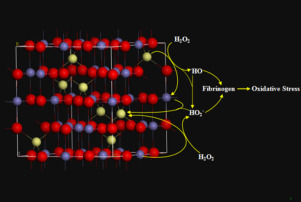Journal of Inorganic Biochemistry ( IF 3.8 ) Pub Date : 2018-09-12 , DOI: 10.1016/j.jinorgbio.2018.09.008 Lei Wang , Chuansheng Cui , Rui Li , Shuling Xu , Haibo Li , Lianzhi Li , Jifeng Liu

|
Oxidative stress accompanies various diseases associated with chronic inflammation. In this work, H2O2 and H2O2–Fe3O4 magnetic nanoparticles were used as two reactive oxygen species to study the oxidative stress for the structure and polymerization behaviour of fibrinogen molecules. The alterations of secondary structure and component of fibrinogen molecule were characterized by circular dichroism spectra, ultraviolet-visible spectra and fluorescence spectra, the viscoelasticity of fibrinogen solution was studied by dynamic light scattering microrheology. Based on the molecular dynamics simulations and fluorescence properties, the possible oxidative stress sites were analyzed and confirmed by Tb3+ probe. The hydrophobicity/philicity and electrostatic net charges present on the exterior part of the fibrinogen molecules were measured with zeta potential. The height and image analysis obtained from atomic force microscope indicated that oxidative stress of fibrinogen molecules could influence the equilateral junctions of protofibrils and the different cross-linking patterns between the α- and γ-chains, result in the decrease of the fibre size, form a higher proportion of branching and a denser aggregation state. This study will provide insights into the misfolding and fibril formation of disease-associated fibrinogen, facilitate an increased understanding of how oxidative stress in vivo affects the formation and polymerization of fibrin, and support efforts for the improved treatment of patients suffering from the thrombotic disease.
中文翻译:

Fe 3 O 4磁性纳米粒子对血纤蛋白原的氧化作用及其对血纤蛋白形成的影响
氧化应激伴随着与慢性炎症相关的各种疾病。在这项工作中,H 2 O 2和H 2 O 2 –Fe 3 O 4磁性纳米粒子被用作两种活性氧,研究氧化应激对纤维蛋白原分子的结构和聚合行为的影响。通过圆二色光谱,紫外可见光谱和荧光光谱表征了纤维蛋白原分子的二级结构和组成的变化,并通过动态光散射微观流变学研究了纤维蛋白原溶液的粘弹性。基于分子动力学模拟和荧光特性,分析了可能的氧化应激位点,并用Tb 3+进行了确证。探测。用ζ电势测量存在于纤维蛋白原分子外部的疏水性/亲和性和静电净电荷。原子力显微镜的高度和图像分析表明,纤维蛋白原分子的氧化应力可能影响原纤维的等边连接以及α-和γ-链之间不同的交联方式,从而导致纤维尺寸,形式的减小。更高比例的分支和更密集的聚集状态。这项研究将提供与疾病相关的纤维蛋白原的错误折叠和原纤维形成的见解,有助于进一步了解体内的氧化应激如何影响纤维蛋白的形成和聚合,并支持为改善血栓性疾病患者的治疗而做出的努力。











































 京公网安备 11010802027423号
京公网安备 11010802027423号